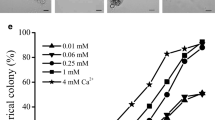Abstract
The green colonial alga Botryococcus braunii is characterized by the ability to produce and accumulate large amounts of hydrocarbons. We isolated and established an axenic clonal strain of B. braunii B70 and investigated the effects of organic carbon sources, including glucose, mannose, fructose, galactose, or acetate, on growth under light and dark conditions. This algal strain had the capacity to grow photo-, mixo-, or heterotrophically. Growth was promoted substantially following exposure of the algae to glucose or mannose under light exposure. Cells could grow under continuous darkness with glucose or mannose. In the presence of glucose under light or dark conditions, cell and colony size, and the intracellular granules containing oil, were markedly larger than those cultured without glucose.








Similar content being viewed by others
References
Abeliovich A, Weisman D (1978) Role of heterotrophic nutrition in growth of the alga Scenedesmus obliquus in high-rate oxidation ponds. Appl Environ Microbiol 35:32–37
Allard B, Casadevall E (1990) Carbohydrate composition and characterization of sugars from the green microalga Botryococcus braunii. Phytochem 29:1875–1878
Belcher JH (1968) Note on the physiology of Botryococcus braunii Kützing. Arch Mikrobiol 61:335–346
Bouarab L, Dauta D, Loudiki M (2004) Heterotropic and mixotropic growth of Micractinium pusillum Fresenius in the presence of acetate and glucose: effect of light and acetate gradient concentration. Water Res 38:2706–2712
Buskey EJ, Hyatt CJ (2006) Use of the FlowCAM for semi-automated recognition and enumeration of red tide cells (Karenia brevis) in natural plankton samples. Harmful Algae 5:685–692
Casadevall E, Dif D, Largeau C, Gudin C, Chaumont D, Desanti O (1985) Studies on batch and continuous culture of Botryococcus braunii: hydrocarbon production in relation to physiological state, cell ultrastructure, and phosphate nutrition. Biotechnol Bioeng 27:286–295
Chisti Y (2007) Biodiesel from microalgae. Biotechnol Adv 25:294–306
Eisentraeger A, Dott W, Klein J, Hahn S (2003) Comparative studies on algal toxicity testing using fluorometric microplate and Erlenmayer flask growth-inhibition assays. Ecotox Environ Safety 54:346–354
Endo H, Sanasawa H, Nakazima K (1977) Studies on Chlorella regularis, heterotrophic fast-growing strain. Mixotrophic growth in relation to light intensity and acetate condition. Plant Cell Physiol 18:199–205
Gregor J, Maršálek B (2004) Freshwater phytoplankton quantification by chlorophyll a: a comparative study of in vitro, in vivo and in situ methods. Water Res 38:517–522
Gregor J, Maršálek B, Sipkova H (2007) Detection and estimation of potentially toxic cyanobacteria in raw water at the drinking water treatment plant by in vivo fluorescence method. Water Res 41:228–234
Gross W, Schnarrenberger C (1995) Heterotrophic growth of 2 strains of the acido-thermophilic red alga Galdieria sulphuraria. Plant Cell Physiol 36:633–638
Kasai F, Kawachi M, Erata M, Wasanabe MM (2004) NIES-Collection list of strains, 7th edn. National Institute for Environmental Studies, Tsukuba, p 49
Komarek J, Marvan P (1992) Morphological differences in natural populations of the genus Botryococcus (Chlorophyceae). Arch Protistenk 141:65–100
Lalibertè G, de la Noüe J (1993) Auto-, hetero-, and mixotrophic growth of Chlamydomonas humicola (Chlorophyceae) on acetate. J Phycol 29:612–620
Lee SJ, Yoon BD, Oh HM (1998) Rapid method for the determination of lipid from the green alga Botryococcus braunii. Biotechnol Tech 12:553–556
Lupi FM, Fernandes HML, Sá-Correia I, Novais JM (1991) Temperature profiles of cellular growth and exopolysaccharide synthesis by Botryococcus braunii Kütz. UC58. J Appl Phycol 3:35–42
Lutz VA, Sathyendranath S, Head EJH, Li WKW (1998) Differences between in vivo absorption and fluorescence excitation spectra in natural samples of phytoplankton. J Phycol 34:214–227
Lutz VA, Sathyendranath S, Head EJH, Li WKW (2001) Changes in the in vivo absorption and fluorescence excitation spectra with growth irradiance in three species of phytoplankton. J Plankton Res 23:555–569
Marquez FJ, Sasaki K, Kakizono T, Nishio N, Nagai S (1993) Growth characteristics of Spirulina platensis in mixotrophic and heterotrophic conditions. J Ferment Bioeng 76:408–410
Miao X, Wu Q (2006) Biodiesel production from heterotrophic microalgal oil. Biores Technol 97:841–846
Porra RJ (2002) The chequered history of the development and use of simultaneous equations for the accurate determination of chlorophyll a and b. Photosynth Res 73:149–156
Satoh S, Vudikara LQ, Kurano N, Miyachi S (2005) Evaluation of sensitivity of marine microalgal strains to heavy metals, Cu, As, Sb, Pb and Cd. Environ Internat 31:713–722
Sawayama S, Minowa T, Dote Y, Yokoyama S (1992) Growth of the hydrocarbon-rich microalga Botryococcus braunii in secondarily treated sewage. Appl Microbiol Biotechnol 38:135–138
Sawayama S, Minowa T, Dote Y, Yokoyama S (1999) Possibility of renewable energy production and CO2 mitigation by thermochemical liquefaction of microalgae. Biomass Bioenerg 17:33–39
Tenaud M, Ohmori M, Miyachi S (1989) Inorganic carbon and acetate assimilation in Botryococcus braunii (Chlorophyta). J Phycol 25:662–667
Vonshak A, Cheung SM, Chen F (2000) Mixotrophic growth modifies the response of Spirulina (Arthrospira) platensis (Cyanobacteria) cells to light. J Phycol 36:675–679
Weetall HH (1985) Studies on the nutritional requirements of the oil-producing alga Botryococcus braunii. Appl Biochem Biotech 11:377–391
Wolf FR, Nonomura AM, Bassham JA (1985) Growth and branched hydrocarbon production in a strain of Botryococcus braunii (Chlorophyta). J Phycol 21:388–396
Zhang K, Kojima E (1988) Effect of light intensity on colony size of microalga Botryococcus braunii in bubble column photobioreactors. J Ferment Bioeng 86:573–576
Zhila NO, Kalacheva GS, Volova TG (2005) Influence of nitrogen deficiency on biochemical composition of the green alga Botryococcus. J Appl Phycol 17:309–315
Acknowledgments
We thank Prof. Kunimitsu Kaya of the University of Tsukuba, Japan for providing data on the analysis of hydrocarbons in strain B70. This study was supported partly by a fund from the Japanese Ministry of the Environment, the Japan Society for the Promotion of Science, and the Japan Science and Technology Agency.
Author information
Authors and Affiliations
Corresponding author
Rights and permissions
About this article
Cite this article
Tanoi, T., Kawachi, M. & Watanabe, M.M. Effects of carbon source on growth and morphology of Botryococcus braunii . J Appl Phycol 23, 25–33 (2011). https://doi.org/10.1007/s10811-010-9528-4
Received:
Revised:
Accepted:
Published:
Issue Date:
DOI: https://doi.org/10.1007/s10811-010-9528-4




